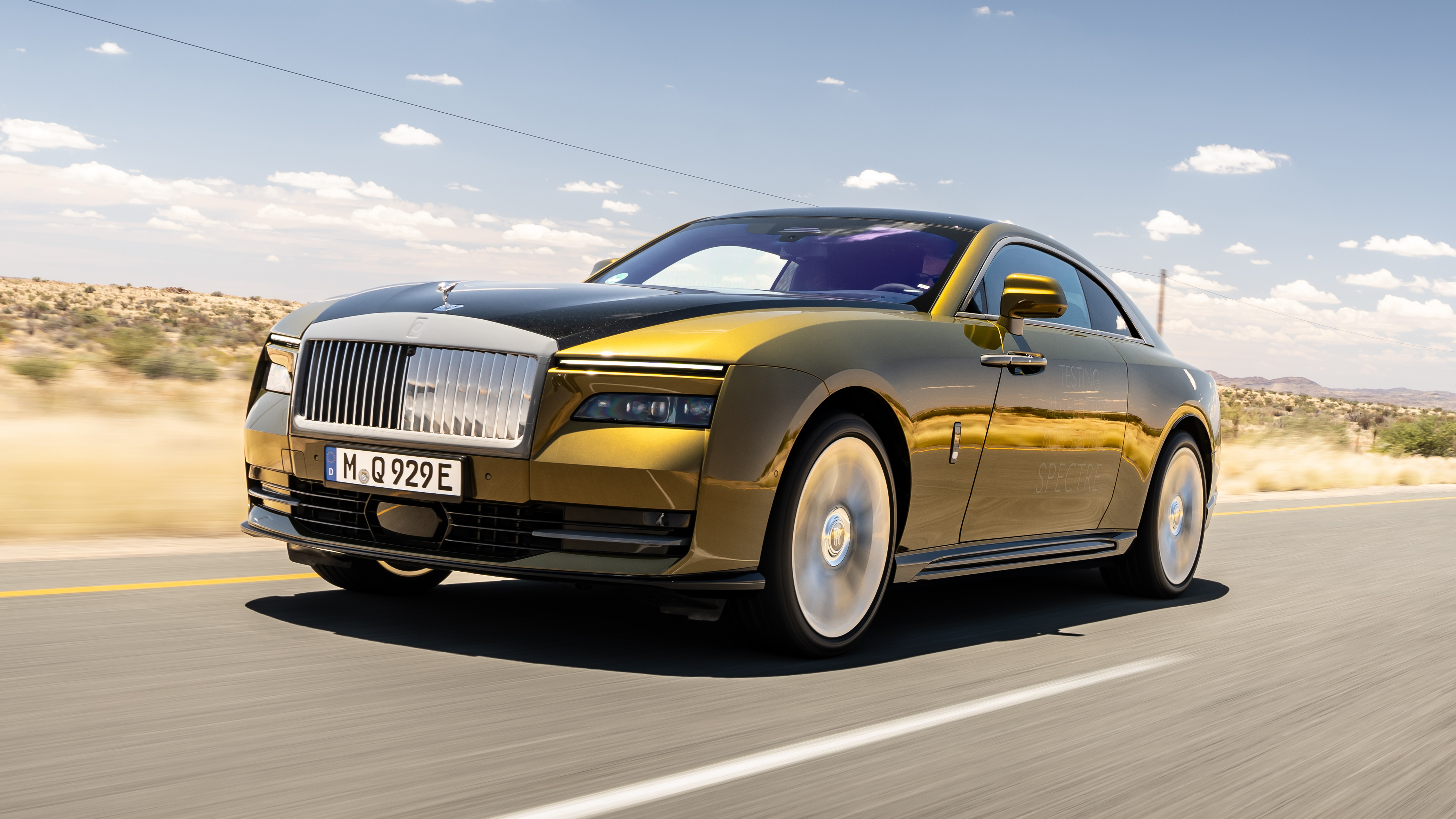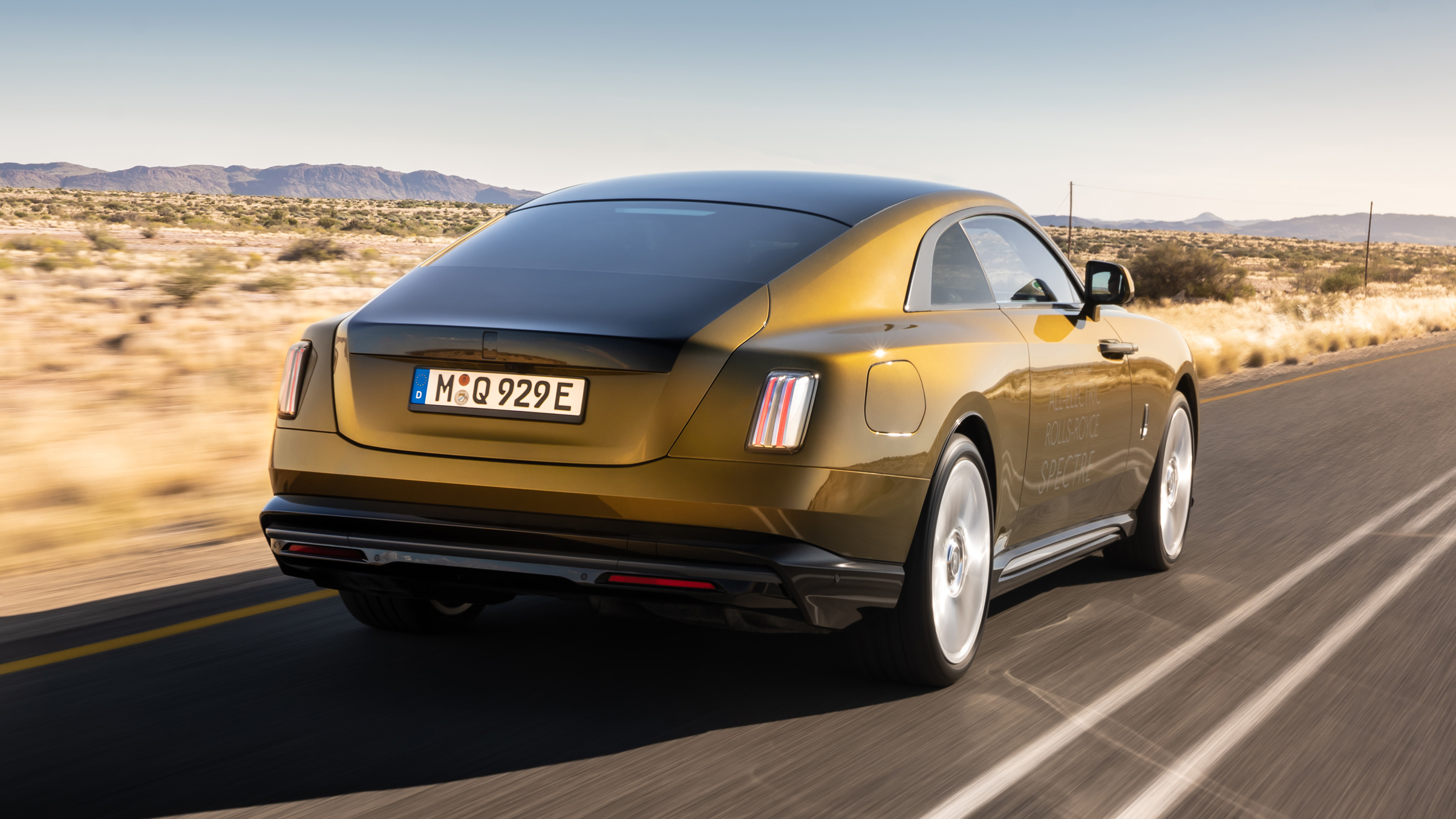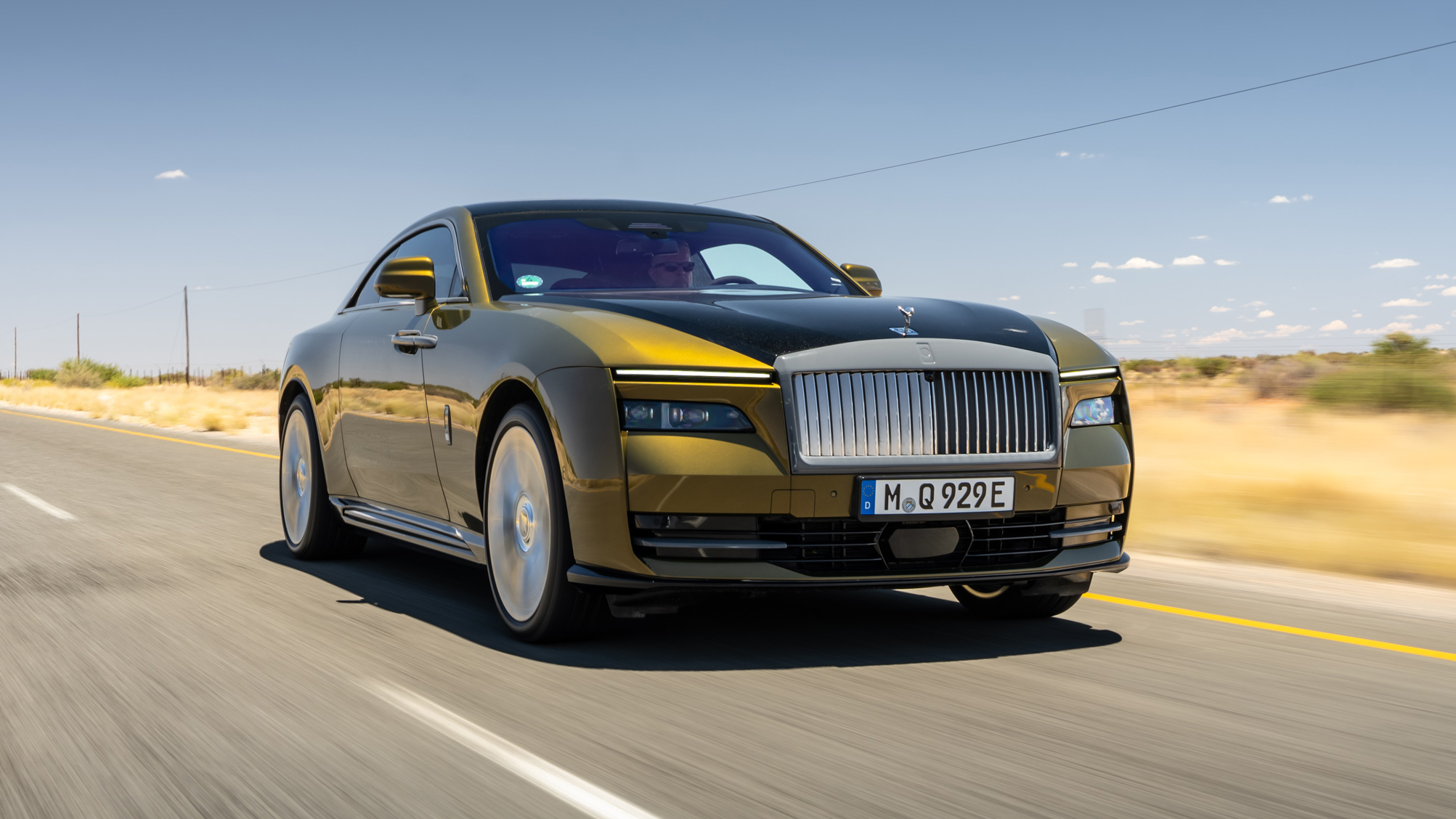
Rolls-Royce Spectre prototype review: a truly bewitching thing to drive
It’s great to see the Spectre in daylight and on the move.
If it looks imposing in photos, this thing is unarguable in the flesh. It’s a huge statement car, perhaps even more so now that Rolls-Royce has finally embraced electrification. You could genuinely say the Spectre has been 120 years in the making. Charles Rolls was pro-EV before he’d even met his future business partner, Henry Royce, in 1904. Fast forward to 2011’s Phantom EV one-off, perfectly persuasive but hobbled by its inferior range, and then the 103 EX concept in 2016, a fabulous slingshot into a future still to come.
It’s only now that the technology has reached a point at which CEO Torsten Müller-Ötvös believes an electric Rolls is feasible. So it’s farewell to the twin-turbo V12 and hello full electrification. NB: There will be further iterations of combustion-engined Rolls-Royces up to 2030, but any new product will be fully electric.
But electrification suits the Rolls-Royce mission, right?
Absolutely. What better way to achieve automotive Zen and total mechanical refinement than by replacing the single biggest source of noise, vibration and harshness with a seamless, silent electric powertrain? Although Rolls had pretty much eliminated every trace of NVH anyway. Now they can take the obsession even further.
So how does the Spectre feel?
Actually, ‘feel’ is the key word, though not perhaps in the traditional road-testy sense. It’s an idea Müller-Ötvös gives particular emphasis to. Remember, the Rolls Phantom is a car that can be driven with a finger-tip touch on the wheel, and has a memorable grace and delicacy to its responses despite being the size of a small building. The Spectre is definitely more spirited but it’s still no sports car. Nor is it meant to be. It’s five metres long, two metres wide and weighs over three tonnes with even a modestly proportioned human behind the wheel. So there’s a limit to what its engineers can do in the face of physics.
Are you saying it handles like a cross-channel ferry?
Absolutely not. It has amazing poise despite its mass, flows like mercury along the road, and its control weights are all very pleasingly calibrated. We’re here in South Africa to observe as these things are finessed in a final phase of hot weather testing. True steering feel is a dark art, and no-one is going to confuse the Spectre with, say, a Lotus Elise (forever the benchmark even now it’s gone). But there is a linearity and balance here that is truly special.
The battery weighs 700kg on its own, so even with its aluminium chassis the Spectre is unavoidably heavy. At least its location under the floor helps promote a useful centre of gravity. An active rear axle also enhances low-speed manoeuvrability, and all-wheel drive is a given.
As for the fabled Rolls-Royce ride quality, the components are familiar from the Ghost. There’s double wishbone suspension at the front and a multi-link set-up at the rear, air springs all-round and adaptive dampers, although there’s only one set-up. Rolls-Royce shuns the idea of multiple, configurable driving modes, and how refreshing is that?
As on the Ghost, the Spectre has the Planar suspension system, which adds a mechanical mass damper on the upper wishbone on the front suspension to enhance body control. The Spectre might be the best solution to the UK’s pothole epidemic, albeit a rather expensive one.
You worked all this out from a drive in a pre-production car?
Yes, on some spectacular roads about 90 minutes from Cape Town, on the Franschhoek Pass and through the Mont Rochelle nature reserve (watch out for the snakes and baboons). Spectre project leader Joerg Wunder is riding shotgun, as he and the team near the end of a globe-straddling two million-mile testing regimen. Joerg insists that the car TG.com is driving is about 65 per cent done, but it feels much closer to the finish line than that. Then again, Rolls-Royce is all about chasing perfection and an electric powertrain poses some very specific challenges in that regard.
Such as?
There’s nowhere for even the tiniest squeak, vibration or wind noise kerfuffle to hide. In the Spectre, the sound of a pin dropping on the lambswool rug could send the otherwise mild-mannered Joerg into an apoplexy. He and his team are on the lookout for ‘hidden inputs’, and interrogate every component for unwelcome vibrations.
Top Gear
Newsletter
Thank you for subscribing to our newsletter. Look out for your regular round-up of news, reviews and offers in your inbox.
Get all the latest news, reviews and exclusives, direct to your inbox.
On the other hand, humans don’t actually enjoy total silence, as anyone who has ever experienced an anechoic chamber will attest. “It can also be a safety issue,” Joerg says. “You need a certain amount of noise to enable the driver to place the car properly on the road, and to know what to do on the approach to a corner.” In other words, there’s a balance to be struck between eerie, discombobulating calm and the correct sort of noise for a Rolls-Royce. That and making sure the door seals don’t freeze and crack in sub-zero conditions or melt in the heat.
What were your findings?
Rolls talks in terms of marginal gains, an idea popularised by former British Olympic cycling boss, Dave Brailsford. If you really sweat the details, the end result will be greater than the sum of its parts. This explains why Joerg grimaces as we head past the 100mph mark – on a private track near the Franschhoek Motor Museum – and the wind kicks up a bit of a fuss around the door mirrors. He mumbles something in German as the doors lock with a rather weak-sounding ‘kang’ rather than a Rolls-appropriate ‘whump’.
And there’s a squeak coming from the driver’s seat, but that’s because I’ve motored it as far back as it’ll go – not as far as you’d think, incidentally, despite the car’s exterior vastness – and it disappears when I ease it forward a smidgeon. This is all minor stuff in the grand scheme of things, but then a Rolls-Royce is a very grand automotive scheme, and this one is going to cost the thick end of £400k by the time a prospective owner has finished specifying it. Most of these people are on first-name terms with Müller-Ötvös and engineering director, Dr Mihiar Ayoubi. And they’re not the shy and retiring type.
Working on a car like that must drive everyone to distraction.
Good is certainly not good enough. Even at this stage, however, this electrified Rolls-Royce – the most important model the company has made since 1906’s Silver Ghost, according to Müller-Ötvös – is simply the most refined motor car I’ve driven. Its ambience, atmosphere and the very experience of travelling in it are unlike anything else.
If you were to get really granular with the criticisms, I’d personally like a touch more weight in the steering, and maybe a little more feel at the top of the brake pedal. Oh, and the brake regen effect – triggered by a tiny little ‘B’ button on the drive controller – in one-pedal driving mode could be a bit more meaningful. But another driver might disagree, and the fact is the Spectre feels like a precision-engineered, supremely well-oiled machine. Only with less oily bits than usual. It’s a truly bewitching thing to drive. Big, but bewitching. And not a mobile sensory deprivation tank.
What about the powertrain?
Rolls is keeping its powder dry on the details, but it’s safe to assume the hardware is at least heavily related to the set-up in the BMW i7 and iX. This is good news because they’re both brilliant. But Rolls-Royce, mindful of the over-arching relationship, is extremely keen to put some fresh air between itself and BMW. So the Spectre gets its own bespoke software and the integration is all singularly Rolls-Royce. Its ‘step-off’ is even smoother than the i7’s, its overall calibration more decorous.
It will also have a more powerful battery – we’d guess at 120kWh, which puts it right up there with the EV big guns. A 664lb ft torque figure is confirmed, but the exact power output remains a matter of speculation. North of 600bhp, surely, although Rolls is disinterested in any sort of power race. If the motors are the same as BMW’s, they’re electrically excited synchronous motors rather than ones with fixed permanent magnets, eliminating the need for rare earth metals in the rotor.
Charging software is always improving, and while Rolls claims a range of 310 miles WLTP , that’s actually much less of an issue in this car than in other EVs. Why? Because the average Rolls owner has seven cars in his or her garage, and the Spectre is likely to be a special occasion drive only. The Phantom, with its olde worlde combustion V12, can do the long-haul stuff. Or the private jet. You are unlikely to see a Spectre owner eating a Starbucks lemon muffin at South Mimms services while they hose energy into the car.
Sounds like a terrible way to live.
Even in these tricky times, there’s a lot of money sloshing about the world. And increasingly it’s being made by younger people; the average age of a Rolls customer has dropped from 56 in 2010 to 42, a good proportion of whom are women. If we do ever get to a second Roaring Twenties, the Spectre will be one of the poster cars for the new age, just as Rolls-Royce was in the peak coachbuilding era a century ago.
Can you explain the Spectre’s design a little more, please?
It’s imposing rather than pretty, but fabulously coherent. The overall shape is defined by a silhouette line, a shoulder line, and what Rolls calls a waft line. It needs those 23in wheels to do its best visual work. Its aero numbers are good, the tapered tail helping it to a 0.25 drag coefficient. The grille is the widest ever on a Rolls, also designed to reduce drag.
The aperture beneath the grille and bumper is the one feeding cooling air. The Spirit of Ecstasy is leaning forward more than before, inviting progress. The split headlights look better resolved here than on other Rollses; the upper ones are permanently lit. The sense of strength this shape and body imparts is extraordinary.
And inside?
You access the cabin via rear-hinged doors, which close when you press the brake pedal. Unlike some high-end rivals, Rolls-Royce has resisted the temptation to deliver a full-bore techno onslaught. Rolls owners, even the ones who have made their billions in Silicon Valley, don’t want that, so there’s no hyperscreen in here. But there are digital instruments for the first time, which do an excellent job of looking exactly the same as analogue ones.
There’s a central touchscreen, which can also be accessed via a rotary controller. The climate control is done by big rotary knobs and the traditional Rolls red and blue discs. It’s a fabulously elegant solution, never bettered. The starlight headlining now extends into the doors, and adds up to almost 4,800 individually lit stars. (It’s a Rolls USP and also the reason why you’ll never see a 7 Series-style ‘theatre screen’ in a Phantom or Ghost.)
The central console is part of the chassis, which helps rigidity, so there’s no funky real estate happening here, unlike in other big EVs. Pity. There would have been room for a boutique hotel in there.
The seats are fabulous, sumptuous but effective during brisk cornering. And Rolls has designed its own monumental audio system, optimising it right from the body-in-white stage. Our prototype is deliberately rather sombre inside, but in Rolls’ bespoke division anything is possible. A brand new paint shop is planned in the next few years, along with an expanded production facility at Goodwood.
Sounds like the ultimate luxury automotive experience.
Experience is the word. At this level, owners are looking for the four-wheeled equivalent of the view from the One57 penthouse in Manhattan, the Project Norse super yacht, or the Gulfstream G650 (a long haul private jet, Elon Musk has one). Based on this sadly brief introduction, the Spectre is in a class of its own right now. Could it be more powerful? Perhaps, but it’s easily fast enough for what it is and what it wants to be. My working definition of cool is when something (or someone) doesn’t waste excess energy trying to define itself. On which basis the Spectre is very cool indeed.
Featured

Trending this week
- Car Review
BMW 1 Series






